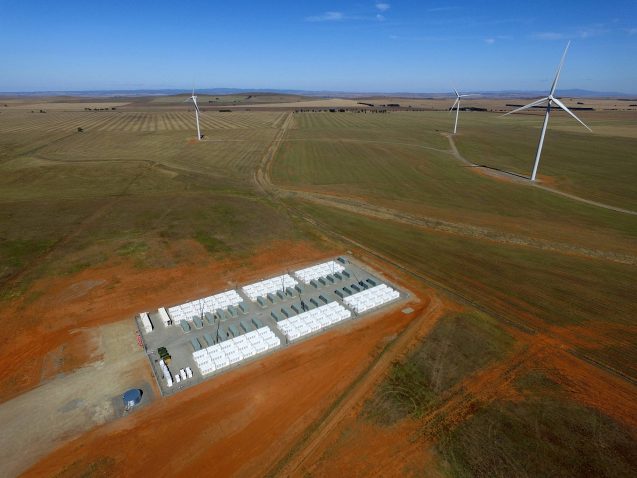
To forestall the most calamitous impacts of climate change, we need to decarbonize society as fast as possible—in other words, remove fossil fuels from all our energy uses. The mission of the Columbia Electrochemical Energy Center (CEEC), which has recently become an affiliate of the Earth Institute, is to speed the decarbonization of the transportation, electrical generation and industrial sectors through fundamental research into improving batteries, electrolyzers and fuel cells. In addition, CEEC is trying to find new materials for next-generation batteries and seeks to better understand why batteries are not being adapted more quickly for multiple uses.
Here are four key areas the CEEC is focused on.
Making electric vehicle batteries safer and cheaper
The global market for electric vehicles (EVs) has been growing about 60 percent each year, and to speed up adoption in the U.S., Senator Chuck Schumer recently introduced a plan to offer cash incentives for people to trade in clunkers for EVs, plug-in hybrids or fuel cell cars. If his proposal gets adopted, it would likely help drivers overcome one of the main hesitations about going electric — the cost.

Electric vehicles are still relatively more expensive than internal combustion engine vehicles. Most EVs rely on lithium-ion batteries, rechargeable batteries with high energy density and long life, which are also most often used in consumer electronics. According to Alan West, co-director of CEEC, the cost of a lithium battery for EVs is now less than $200 per kwH, but getting that price down to $100 per kwH is the “Holy Grail” because it would make EVs competitive with internal combustion engine vehicles.
In addition to trying to bring down costs, researchers at CEEC are attempting to design batteries for electric vehicles that can overcome two other challenges: safety and charging speed.
You have probably seen news reports about cell phones, computers and EVs catching fire because of their lithium-ion batteries, although this is a rare occurrence.
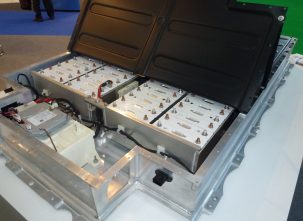
A lithium-ion battery consists of two electrodes, a negatively charged carbon anode and a positively charged lithium-metal cathode, separated by an electrolyte consisting of an organic solvent containing lithium salts, which is flammable. The cathode and the anode need to be kept apart with a polyethylene separator. When the battery is being discharged, lithium ions move from the anode through the electrolyte to the cathode, and free electrons flow through an outside circuit to the cathode, powering the device. When the battery is being charged (plugged into a power source) lithium-ions move from the cathode back to the anode and the electrons return to the anode. What makes lithium-ion batteries sometimes catch fire is a short circuit that occurs when the electrodes come into contact. As the battery is charged and discharged, lithium ions can form uneven surfaces on the electrodes. Lauren Marbella, assistant professor of chemical engineering and principal investigator at CEEC, said, “Whenever you plate lithium, it doesn’t plate smoothly. It will build up microstructures—bumps coming out of the surface. Those structures can pierce the separator and cause a short circuit. And then the battery can go into thermal runaway, which leads to battery fires in some cases.”
Marbella’s team has found that adding very small amounts of other types of chemicals into the electrolyte can stop the growth of microstructures. Now they are trying to understand how and why these chemicals work.
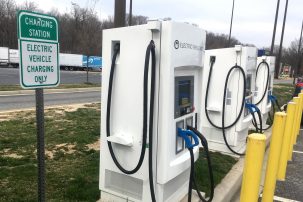
Currently, charging an EV can take anywhere from 30 minutes to 12 hours, depending on the size of the battery and speed of the charging station. West and his colleagues are trying to figure out how to speed up the movement of lithium ions, which would make EV batteries charge faster. This is just one problem that his team is using its research specialty to solve. They build mathematical models to simulate thousands of different conditions to determine the best design of a battery system, given the chemistry of the materials and the function a battery needs to perform.
“I think one of the things that’s very exciting about CEEC is that we have different people working on these very different scales, going from atoms all the way up to entire systems,” said West. “The systems people tell us what the battery needs to do, the atomistic people tell us what these materials can do, and then we try to understand what the best combination of materials is that will satisfy that application through mathematical modeling.”
Designing better batteries for the electrical grid
While producing electricity through solar and wind energy is already competitive with fossil fuel generation, renewable energy sources still have the problem of intermittency—they are affected by location, weather and time of day. Utilities must be able to balance supply and demand in order to deliver reliable, steady energy, so batteries are needed to store energy when it is available and release it when more is required. But so far, batteries have not been fully integrated into the mainstream power grid due to performance, cost and safety issues, regulatory barriers, and the resistance of utilities.
“There are some applications on the grid that will be lithium-ion—it actually makes sense economically today,” said West. “But there are other applications on the grid where the cost has to be significantly lower than $100 kwH, so we’re working on those types of technologies.” This might involve sacrificing energy density—the amount of energy a battery can store—in order to increase safety, extend battery life and drive costs down.
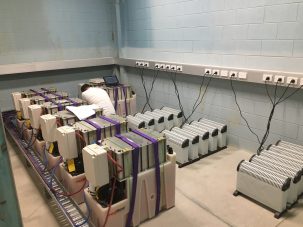
West and CEEC co-director Dan Steingart are working on a zinc-bromine flow battery for use on the electrical grid. Flow batteries, whose chemicals to produce electricity are dissolved in water in separate tanks, can be charged and discharged limitlessly and can provide steady energy over time. Typical zinc-bromine batteries use an electrolyte solution of zinc bromide stored in two tanks. The electrolyte has to flow through the system, which requires multiple pumps—this raises the battery’s maintenance costs. West and Steingart are trying to redesign the system to eliminate external pumps using mathematical models. “Based on the cost of the materials, we know it’s possible to get to the price point required for the application,” said West, “But you’re not going to be able to do that unless we have a really excellent design of the battery system. This is where we use the mathematics. We don’t have to build 500 different batteries to try to find the optimal battery system—we can do this by simulation.”
West’s team has been given an ARPA-E grant from the Department of Energy and is working with Primus Power on this technology. Primus and a few other companies have developed larger scale zinc-bromine systems that have flow, but West said that due to their complexity, it is difficult to achieve the desired price point. His team is trying to develop a long-duration battery that can discharge for between 12 and 24 hours. Right now on the grid, the economics are such that batteries last only about 4 hours since the cost of a battery is proportional to how much energy it can deliver. “If we can do this, we think we can produce a battery that would be as cheap of $30 a kilowatt-hour and possibly last for 20 years,” said West.
West predicts that the first application for this technology could be a battery system for use in the home, about the size of an air conditioning unit outside the house. “We can envision that you’d maybe spend $10,000 to $15,000 for solar panels, and the battery system could be as cheap as $2,000 or $3,000 and with this, you could almost become grid independent.” Moreover, this type of battery could not catch fire.
Investigating new materials for innovative batteries
CEEC scientists are searching for alternatives to lithium, sometimes called beyond lithium technologies, but they also look at how existing batteries could be improved if re-engineered. Some are researching solid-state electrolytes, because if liquids (the organic solvent that is the electrolyte) could be eliminated from lithium-ion batteries, they would no longer catch fire. Other CEEC researchers are working on making ultra cheap batteries. One problem with lithium-ion batteries is that they contain cobalt, which is expensive; moreover, half of it is sourced from the Congo, which has vast natural resources but is politically unstable. Some researchers are using quantum chemistry calculations on the computer to find the next great material that could eliminate the need for cobalt.

Lauren Marbella’s group researches beyond lithium-ion batteries, which entails experimenting with swapping out some component of a conventional lithium-ion battery for another material. They recently began researching potassium-ion batteries. Potassium is relatively cheap because it is more abundant in the Earth’s crust than lithium, which is comparatively rare. Potassium ions also move faster through solutions, which gives them faster charging abilities than lithium. The trade-off, however, is that because potassium atoms are larger than lithium atoms, they make electrode material expand, which causes problems.
Marbella’s lab is also looking at a variety of materials with higher energy density than the current materials used in cathodes, but these materials degrade as they are charged and discharged. Her team is trying to understand what goes wrong when the materials are being used, so those problems can be fixed. They are able to study a battery while it is operating by combining MRI and NMR (nuclear magnetic resonance) scanning techniques. These scans provide a non-invasive way to observe the working batteries from the level of what can be seen with the naked eye all the way down to the atomic level.
“We can purposely charge and discharge the battery inside the instrument and we can actually watch what’s going on inside,” she said. “This gives us more information, so if we can correlate a specific structural change with a change in the electrochemistry or in the performance of the battery, then we can link those two events together and do more to understand the failure.” Identifying why batteries fail is essential to understanding how to make them safer and longer lasting.
Developing fuel cells and electrolyzers for larger scale uses
While battery technology will be used to wean transportation and the grid off of fossil fuels, industry (responsible for 22 percent of U.S. greenhouse gas emissions), which largely relies on fossil fuels to produce high heat and operate heavy machinery, will likely require renewable energy to decarbonize. CEEC is working on fuel cells and electrolyzers that could enable hydrogen to replace natural gas in many industry applications.

A fuel cell uses hydrogen and oxygen to produce electricity and water. Like batteries, a fuel cell consists of an anode, a cathode, and an electrolyte. A catalyst at the anode splits the hydrogen into positively charged hydrogen ions and negatively charged electrons. The hydrogen ions can pass through the electrolyte to the cathode, while the electrons must flow to the cathode through an external circuit, thus producing electricity. When the ions, electrons and oxygen meet at the cathode, they form water. An electrolyzer reverses this process: It takes water and, using excess electricity, ideally from a renewable source, splits it into hydrogen and oxygen. The oxygen and hydrogen can be stored in a fuel cell or tank and then the hydrogen can be tapped to produce electricity when needed; or it can be used to produce other chemicals.
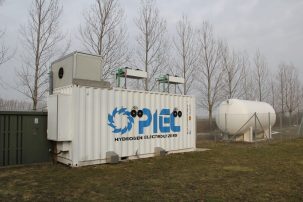
Photo: Rh2network
Hydrogen has much potential for large-scale applications because great amounts can be stored for long periods of time, but producing hydrogen fuel is still expensive. Jingguang Chen, chemical engineering professor and CEEC principal investigator, is studying the use of nonprecious metals as catalysts in electrolyzers and fuel cells, as well as trying to make the materials currently used as catalysts more efficient. “We believe that when you get to maybe 80 percent renewables on the grid, these types of alternative technologies [fuel cells and electrolyzers], may be economically attractive,” said West.
How close are we to solving the energy storage problem?
West believes there is still some time to develop the batteries that the world needs for a decarbonized future. “The amount of storage we require on the grid depends on how many renewables are on the grid—and we’re not going to go from 10 percent renewables to 80 or 100 percent renewable overnight,” he said. He added that today’s battery technology would probably be sufficient if New York State reaches 50 percent renewables by 2030. But by the time New York reaches 80 percent renewables, which West estimates will happen around 2040, “we need these new technologies that will be much cheaper… It still takes 20 years, however, to go from a great new idea to commercialization and permits, so we need to be doing this now.”
New legislation in New York State requires 70 percent renewables by 2030, and 100 percent by 2040 — so there is no time to lose.
A recent report from the Rocky Mountain Institute estimates that $150 billion will be invested into advanced battery technology through 2023, a sign that the global energy transition is occurring faster than models projected. These advances in technology could achieve better batteries at a cost of $87/kWh by 2025. The report predicted that lithium-ion batteries will remain dominant until 2023; but by 2030, alternative advanced battery technology will surge into the marketplace. The researchers at CEEC are leading the charge.



